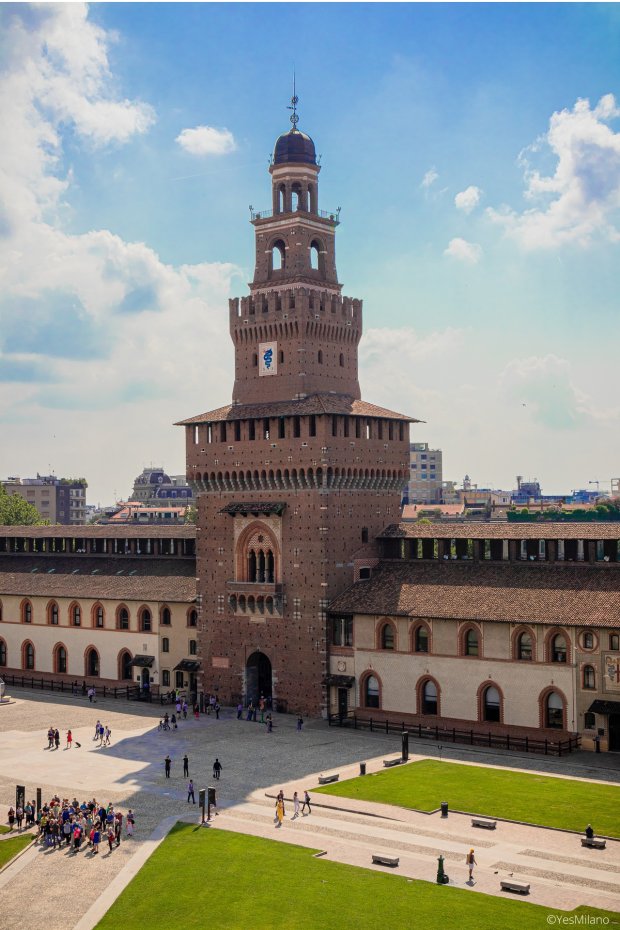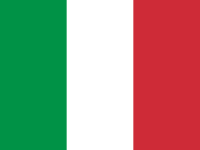A Castle in Milan

Visitors arriving in Milan will most likely walk through the elegant 19th Century Galleria Vittorio Emanuele to reach Piazza del Duomo, the very centre – both spiritually and spatially – of the city. As they come out in the open, they will have the imposing marble Cathedral slightly to their left and a spectacular view of the expanse of the Piazza. If they glance to their right though, they will glimpse in the far distance, at the opposite end of a long pedestrian thoroughfare, a striking crenelated tower exhibiting all the fascinating power of the Renaissance. To those familiar with Milan, the mighty tower marks the entrance to Castello Sforzesco, one of the city’s prime attractions and a most significant historic landmark.
Alas, the tower is not the original one: it was first built in the mid-fifteenth century, in the heyday of the Sforza family, who were then Lords of Milan and of a Duchy that included a good part of northern Italy. This was one of the Renaissance’s most splendid courts, and the Duke of Milan had unsurprisingly called up from Florence a famous architect, il Filarete, who drew up the tower and famously kept embellishing it, until the Duke had had enough and proceeded to entrust the rest of the Castle’s renovation to a military engineer. In 1521, after the Sforza had been dethroned by the invading French, the tower, that was then being used as a gunpowder depot, blew up and was completely destroyed. Today’s tower is the result of a painstaking rebuilding effort started in 1905 by architect Luca Beltrami, who based his work on remaining sketches and prints and bequeathed the city something closely resembling the original.
The Castello was always at the heart of Milan’s history: when the city became the Capital of the Western Roman Empire in AD 286, a Castra Praetoria, housing the Emperor’s personal guard, already existed on the site. But the Castle as we see it was largely built in the early fifteenth century with materials brought to the site from distant quarries through the Navigli canal network, much in the same way as the Duomo. Of course, the Castello now especially brings to mind the glorious reign of Duke Ludovico il Moro (il Moro as he apparently had a dark complexion), when Leonardo da Vinci himself was commissioned a number of important works by Ludovico. Leonardo was very much involved with the Castello: he possibly designed parts of it, he left his signature in the magnificent Sala delle Asse - but he really was all over the place, painting, stage-managing court pageants and organizing celebrations on different occasions. He also built a gigantic mock-up of the famous bronze horse he never was able to cast, which was later destroyed by the invading French troops – the same that turned Sala delle Asse into a stable.
After Milan lost its independence, the Castello became a fortress, barracks and prison for subsequent occupiers: it was French, Spanish, and Austrian. As a symbol of foreign power, it was a hated place until Milan finally became a part of Italy. It now stands as a proud symbol of a glorious past as well as one of Milan’s most important exhibition sites: it houses museums, archives and libraries, not to mention temporary exhibitions. From Michelangelo’s Pietà Rondanini to Leonardo’s Sala delle Asse, from paintings by the great Italian Masters in the Art Gallery to the different theme museums, such as the one dedicated to musical instruments, it is a veritable treasure trove for art lovers. Most of all, it is nice to walk in the Castle’s courts and take in the atmosphere and the memories of the past, surrounded by the symbols of ancient Milan.
As the City’s most important public building - the Duomo is, after all, a church - the Castello has a tradition of hosting public and private events of particular significance. It comes as no surprise that it has been reserved for the World Routes’ Networking Night when Milan hosts the great aviation event next October. Delegates will have the whole place to themselves, will be invited to roam around the building and its courts, and will be offered guided visits to the various museums and attractions. It will be an exclusive setting for the aviation industry’s most important event in recent years, as it will lay out projects and partnerships for a post-pandemic future in air travel. Milan certainly hopes to be at the centre of this future, and to welcome new flights and travel opportunities – in keeping with its historic vocation as a hub of commerce and exchanges between people. The Duke, back in the Castello’s glory days, would have appreciated.


